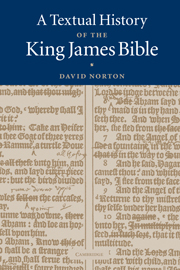Book contents
- Frontmatter
- Contents
- List of illustrations
- Acknowledgements
- List of abbreviations
- PART 1 THE HISTORY
- 1 Making the text
- 2 Pre-1611 evidence for the text
- 3 The first edition
- 4 The King's Printer at work, 1612 to 1617
- 5 Correcting and corrupting the text, 1629 to 1760
- 6 Setting the standard, 1762 and 1769
- 7 The current text
- PART 2 THE NEW CAMBRIDGE PARAGRAPH BIBLE
- PART 3 APPENDICES
- Bibliography
- General index
- Word index
- Index of biblical references
5 - Correcting and corrupting the text, 1629 to 1760
from PART 1 - THE HISTORY
- Frontmatter
- Contents
- List of illustrations
- Acknowledgements
- List of abbreviations
- PART 1 THE HISTORY
- 1 Making the text
- 2 Pre-1611 evidence for the text
- 3 The first edition
- 4 The King's Printer at work, 1612 to 1617
- 5 Correcting and corrupting the text, 1629 to 1760
- 6 Setting the standard, 1762 and 1769
- 7 The current text
- PART 2 THE NEW CAMBRIDGE PARAGRAPH BIBLE
- PART 3 APPENDICES
- Bibliography
- General index
- Word index
- Index of biblical references
Summary
The first Cambridge edition, 1629 (H424)
In 1534 Henry VIII granted a charter to Cambridge University licensing it to ‘assign, appoint and in perpetuity have among them … Three Stationers and Printers or Sellers of Books’. These men were to ‘have lawful and incontestable power to print there all manner of books approved, or hereafter to be approved, by the aforesaid Chancellor or his deputy and three doctors there’. In keeping with this charter, John Legate, the second of the University's printers, ventured into Bible printing in the 1590s (H207 and H208). Occasional attempts on the lucrative Bible market continued. In November 1623 the Vice-Chancellor of Cambridge was ‘willing to forgo the printing of the Bible in 8° and be content with 4° and 12°’. Though this is the earliest surviving reference to the University wanting to print the KJB, it implies earlier suits by its appearance of offering a compromise. At this point the University may simply have been trying to establish its position, particularly in relation to octavo Psalm books its printer, Cantrell Legge, had lately printed (Greg, pp. 64, 181). However, there is some reason to think that it had started work on or was contemplating a new edition of the KJB. The initial response was totally discouraging: in December the Privy Council forbad printing of the Bible by the University printer (Greg, pp. 64, 181).
- Type
- Chapter
- Information
- A Textual History of the King James Bible , pp. 82 - 102Publisher: Cambridge University PressPrint publication year: 2005



